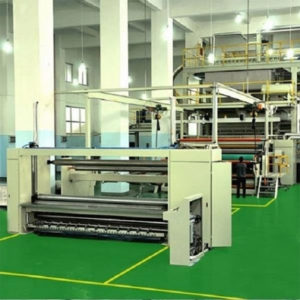Polypropylene fabric is available for sale in various forms to cater to different applications and customer needs.
Some of the common forms in which polypropylene fabric can be found include:
- Rolls: Polypropylene fabric is often sold in rolls, which are typically wound around cardboard or plastic cores. These rolls are available in different widths and lengths, making them suitable for a wide range of applications. For example, rolls of polypropylene fabric are commonly used in packaging, agriculture, geotextiles, and as a protective covering.
- Sheets: Polypropylene fabric sheets are pre-cut pieces of fabric available in various dimensions. These sheets are convenient for specific projects or applications where precise sizing is required. They are used in crafting, sewing, and various DIY projects.
- Bags: Polypropylene fabric is used to make reusable shopping bags, tote bags, and promotional bags. These bags are often available for sale and are popular for their durability and eco-friendly properties.
- Sacks: Woven polypropylene sacks or bags are commonly used for packaging bulk goods, such as grains, seeds, fertilizers, and construction materials. They are available in different sizes and with various closure mechanisms like drawstrings, zippers, or sewn tops.
- Geotextiles: Polypropylene fabric is used in the construction and civil engineering industry as geotextiles. These specialized fabrics are available in rolls or specific forms designed for soil stabilization, erosion control, drainage, and filtration applications.
- FIBC (Flexible Intermediate Bulk Container) Bags: FIBC bags, also known as bulk bags or super sacks, are large containers made from polypropylene fabric. They are available for sale in various sizes and configurations and are used for transporting and storing bulk materials like powders, granules, and chemicals.
- Filter Media: Polypropylene fabric is used as filter media in various applications, such as air filters, liquid filtration, and dust collection. Filter cartridges and filter bags made from polypropylene fabric are available for sale.
- Apparel and Textiles: Polypropylene fabric is used in the production of a range of apparel and textile products, including disposable coveralls, lab coats, aprons, and protective clothing for various industries. These items can be found for sale in retail stores or through specialized suppliers.
- Medical and Hygiene Products: Polypropylene fabric is used in the manufacture of medical face masks, surgical gowns, and hygiene products like disposable diapers and sanitary napkins. These products are often available for sale in medical supply stores or online.
- Industrial Fabrics: Specialty polypropylene fabrics are available for sale for industrial applications like conveyor belts, packaging materials, and more.
The specific form and product type of polypropylene fabric available for sale will depend on the intended use and industry. Customers can choose the most suitable form and product based on their requirements, whether it’s for industrial, agricultural, construction, or consumer applications.
What are the environmental and sustainability considerations associated with the use of polypropylene fabric, and are there eco-friendly options available for sale?
Polypropylene fabric has both environmental benefits and challenges, and there are efforts to offer more eco-friendly options. Here are some key environmental and sustainability considerations associated with the use of polypropylene fabric:
Environmental Benefits:
- Recyclability: Polypropylene fabric can be recycled, which reduces the environmental impact by extending the material’s life cycle. Recycled polypropylene fabric can be used in various applications, including packaging and textiles.
- Low Water Usage: The production of polypropylene fabric generally requires less water compared to natural fiber materials like cotton. This can be advantageous in regions with water scarcity concerns.
- Lightweight: Polypropylene fabric is lightweight, polypropylene fabric for sale which can lead to reduced transportation-related energy consumption and emissions.
- Durability: Polypropylene fabric is known for its durability and resistance to moisture, making it long-lasting and reducing the need for frequent replacements.
Environmental Challenges:
- Non-Biodegradable: Polypropylene is a synthetic material and is not biodegradable. When not properly managed, it can contribute to plastic pollution.
- Microplastics: Over time, polypropylene fabrics can shed microplastic particles during use and washing. These particles can enter the environment and marine ecosystems.
Eco-Friendly Options:
Efforts are underway to develop and promote more eco-friendly alternatives:
- Recycled Polypropylene: Recycled polypropylene, which is derived from post-consumer or post-industrial sources, is an eco-friendly option. It reduces the demand for virgin materials and promotes recycling.
- Biodegradable Additives: Some manufacturers are incorporating biodegradable additives into polypropylene fabric to enhance its biodegradability under certain conditions.
- Bio-based Polypropylene: Researchers are exploring bio-based polypropylene, which is derived from renewable sources like plant-based feedstocks. This has the potential to reduce the carbon footprint of polypropylene fabric.
- Sustainable Production Practices: Manufacturers are implementing sustainable production practices, such as using energy-efficient machinery and reducing waste and emissions.
- Closed-Loop Recycling: Closed-loop recycling systems are being developed, where polypropylene fabric can be collected, recycled, and used in new products.
To make eco-friendly choices when purchasing polypropylene fabric, consider the following:
- Look for products made from recycled polypropylene.
- Choose products that use bio-based or biodegradable additives if your application allows.
- Support brands and manufacturers that promote sustainable and responsible production practices.
- Recycle or properly dispose of polypropylene fabric at the end of its life to minimize its environmental impact.
It’s important to note that the environmental impact of polypropylene fabric depends on factors such as its disposal, recycling practices, and the specific application. Efforts to minimize the environmental footprint of polypropylene fabric are ongoing, and consumers can play a role in supporting more sustainable options.
